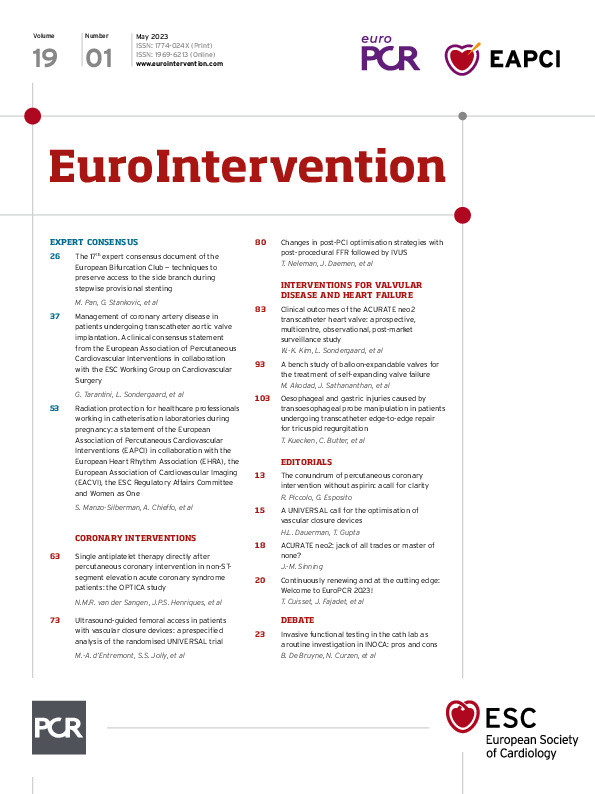Aspirin is widely recognised as an essential component of antithrombotic therapy for secondary prevention, with societal guidelines recommending its use prior to percutaneous coronary intervention (PCI) and for lifelong maintenance therapy thereafter. The development of more potent P2Y12 receptor inhibitors, which provide a predictable antiplatelet effect, has led a shift in clinical research towards monotherapy with P2Y12 receptor inhibitors, without aspirin1. Aspirin discontinuation on a background of P2Y12 receptor inhibition has been tested at varying intervals, including 12 months, 3 to 6 months, and 1 month following PCI in experimental arms of randomised trials. This approach presents a potential win-win scenario, reducing the risk of both ischaemic and bleeding events in comparison to dual antiplatelet therapy (DAPT). Despite this, aspirin remains deeply engrained in clinical practice, and the dogma of performing PCI without aspirin has not been challenged by a study.
In this issue of EuroIntervention, van der Sangen and colleagues report on the results of the Optical Coherence Tomography-Guided PCI with Single Antiplatelet Therapy (OPTICA) study, a pilot trial involving 75 patients with non-ST-elevation acute coronary syndrome who underwent PCI with new-generation drug-eluting stents2. The study assessed the use of P2Y12 receptor inhibitor monotherapy, with ticagrelor being used in 85% of patients, immediately after PCI completion. Intracoronary imaging with optical coherence tomography was used in approximately 45% of patients, although one might have expected a wider use based on the study title. Adequate platelet inhibition was confirmed in all patients, except for one who remained on DAPT after PCI. The anatomical complexity in the study was low to moderate, with around 70% of cases being single-lesion PCI and over 80% of patients requiring the implantation of 1-2 stents. At 6-month follow-up, adverse events occurred at relatively low frequency, with minor bleeding being the most frequent complication (6.7%), followed by repeat revascularisation in non-target vessels (5.3%), and periprocedural myocardial infarction (2.7%). No stent thrombosis, type 1 myocardial infarction, or deaths were reported.
OPTICA is a proof-of-concept study, and therefore it is important to acknowledge some limitations when interpreting the study findings. Firstly, the study was not randomised and lacked a control arm, such as standard DAPT, which could have served as a reference antiplatelet strategy. Secondly, the sample size was considerably underpowered, with stent thrombosis, the most feared complication associated with aspirin withdrawal, being difficult to investigate thoroughly with only 75 patients observed up to 6 months after PCI. Although the study was planned as a single-arm trial, it did not employ an optimal performance goal nor a similar approach; thus, the final sample is not the result of a power calculation nor study hypothesis. Additionally, the study lacked an independent Data and Safety Monitoring Board, as well as a clinical events committee. Therefore, caution should be exercised when interpreting the authors’ conclusion that monotherapy with P2Y12 inhibitors immediately after coronary stenting is feasible without any overt safety concerns.
However, it is important to recognise the pioneering nature of the OPTICA study in exploring a new field in antithrombotic therapy for PCI patients. In this respect, the authors deserve commendation for extending the boundaries of P2Y12 inhibitor monotherapy to day 0 after PCI. Nevertheless, prior to bidding adieu to aspirin after PCI, it is necessary to reflect on the pros and cons of an aspirin-free approach in the first month following PCI. In analogy to the decreased risk of bleeding with P2Y12 inhibitor monotherapy after a short course of DAPT, a consistent benefit can be expected when this approach is applied at an earlier timepoint. However, as the bleeding risk is proportional to the duration and intensity of DAPT, the expected benefit in absolute terms is not substantial for the average patient. Conversely, for a patient at high bleeding risk or at risk of developing a bleeding complication after PCI, the benefit may be considerable and clinically relevant. Despite randomised data from about 30,000-40,000 patients showing the safety and efficacy of P2Y12 inhibitor monotherapy, this approach is still far from being implemented in clinical practice. Aspirin is still prescribed to millions of patients in secondary prevention, despite the fact that the overall data proving its efficacy are based on only 16,000 patients enrolled in outdated randomised trials3. Implementing changes in clinical practice is easier when they are simple to embrace, and thus P2Y12 inhibitor monotherapy after PCI will more likely become the mainstream approach if the transition from DAPT is no longer required. However, a rigorous approach is highly warranted to bring the aspirin-free strategy to the next level. Early aspirin discontinuation in another context, such as PCI patients requiring oral anticoagulant therapy, carries a non-negligible higher risk of stent thrombosis when data from all trials are pooled together. Nonetheless, here, the situation may be different if one takes a risk with the parachute of more potent P2Y12 inhibitors, such as ticagrelor or prasugrel. There is no way to change clinical practice without a well-designed randomised trial, powered for hard clinical outcomes, comparing a low dose of aspirin versus placebo after PCI. For the time being, P2Y12 inhibitor monotherapy should continue to be commenced at least 1 month after PCI.
Conflict of interest statement
The authors have no conflicts of interest to declare.

